Assignment on Family Law PDF
VerifiedAdded on 2022/01/02
|7
|2829
|34
AI Summary
Contribute Materials
Your contribution can guide someone’s learning journey. Share your
documents today.
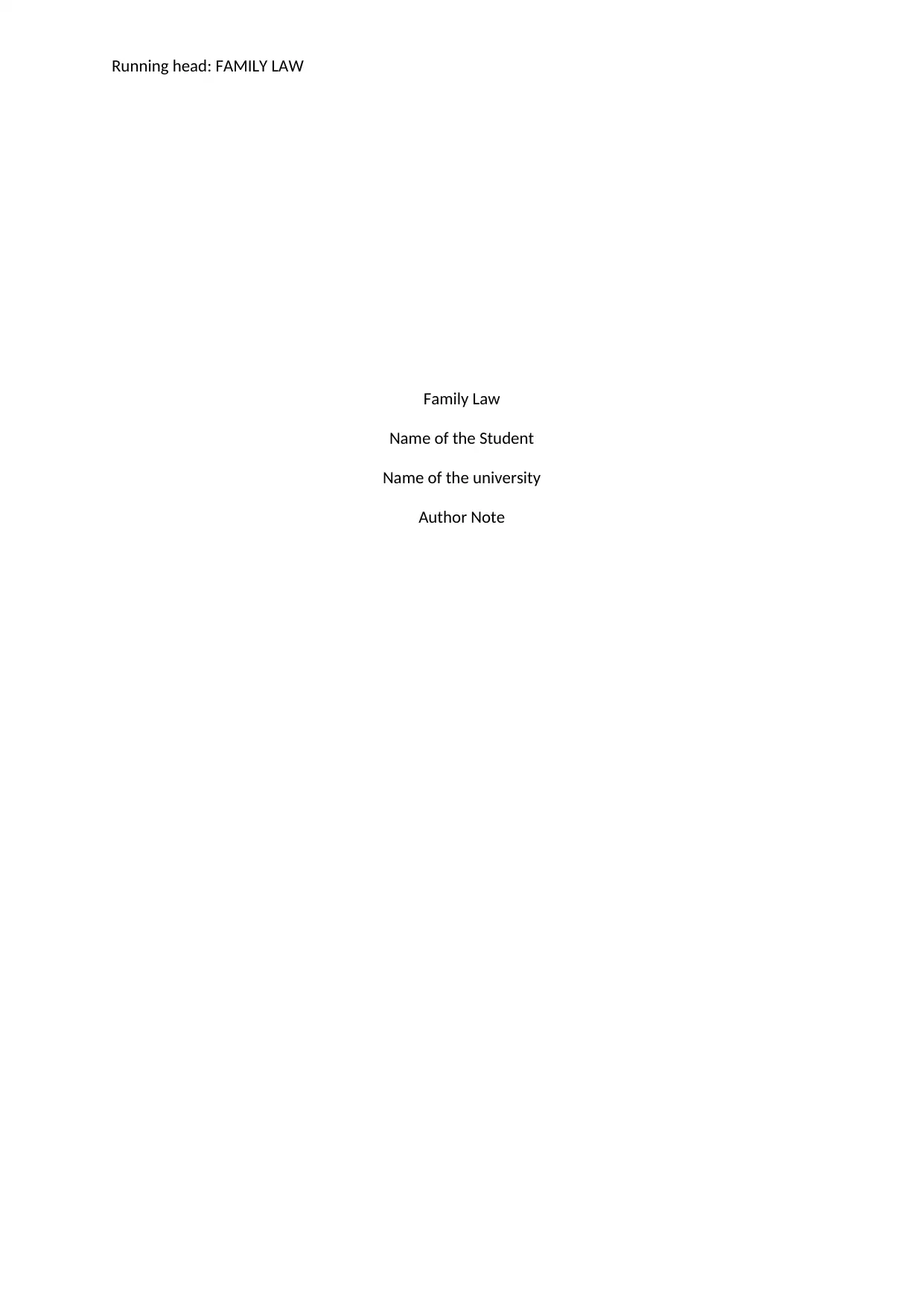
Running head: FAMILY LAW
Family Law
Name of the Student
Name of the university
Author Note
Family Law
Name of the Student
Name of the university
Author Note
Secure Best Marks with AI Grader
Need help grading? Try our AI Grader for instant feedback on your assignments.
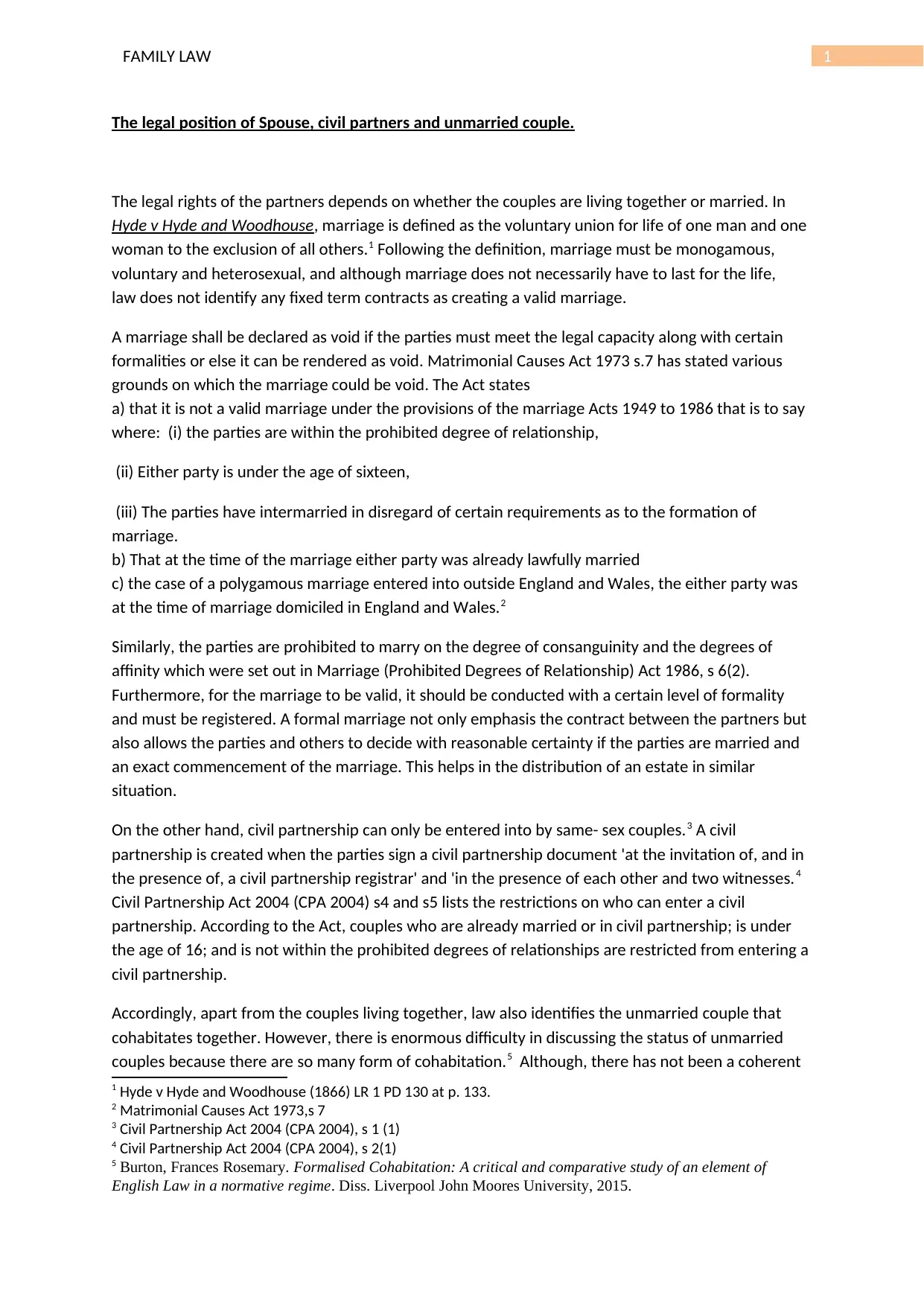
1FAMILY LAW
The legal position of Spouse, civil partners and unmarried couple.
The legal rights of the partners depends on whether the couples are living together or married. In
Hyde v Hyde and Woodhouse, marriage is defined as the voluntary union for life of one man and one
woman to the exclusion of all others.1 Following the definition, marriage must be monogamous,
voluntary and heterosexual, and although marriage does not necessarily have to last for the life,
law does not identify any fixed term contracts as creating a valid marriage.
A marriage shall be declared as void if the parties must meet the legal capacity along with certain
formalities or else it can be rendered as void. Matrimonial Causes Act 1973 s.7 has stated various
grounds on which the marriage could be void. The Act states
a) that it is not a valid marriage under the provisions of the marriage Acts 1949 to 1986 that is to say
where: (i) the parties are within the prohibited degree of relationship,
(ii) Either party is under the age of sixteen,
(iii) The parties have intermarried in disregard of certain requirements as to the formation of
marriage.
b) That at the time of the marriage either party was already lawfully married
c) the case of a polygamous marriage entered into outside England and Wales, the either party was
at the time of marriage domiciled in England and Wales.2
Similarly, the parties are prohibited to marry on the degree of consanguinity and the degrees of
affinity which were set out in Marriage (Prohibited Degrees of Relationship) Act 1986, s 6(2).
Furthermore, for the marriage to be valid, it should be conducted with a certain level of formality
and must be registered. A formal marriage not only emphasis the contract between the partners but
also allows the parties and others to decide with reasonable certainty if the parties are married and
an exact commencement of the marriage. This helps in the distribution of an estate in similar
situation.
On the other hand, civil partnership can only be entered into by same- sex couples.3 A civil
partnership is created when the parties sign a civil partnership document 'at the invitation of, and in
the presence of, a civil partnership registrar' and 'in the presence of each other and two witnesses.4
Civil Partnership Act 2004 (CPA 2004) s4 and s5 lists the restrictions on who can enter a civil
partnership. According to the Act, couples who are already married or in civil partnership; is under
the age of 16; and is not within the prohibited degrees of relationships are restricted from entering a
civil partnership.
Accordingly, apart from the couples living together, law also identifies the unmarried couple that
cohabitates together. However, there is enormous difficulty in discussing the status of unmarried
couples because there are so many form of cohabitation.5 Although, there has not been a coherent
1 Hyde v Hyde and Woodhouse (1866) LR 1 PD 130 at p. 133.
2 Matrimonial Causes Act 1973,s 7
3 Civil Partnership Act 2004 (CPA 2004), s 1 (1)
4 Civil Partnership Act 2004 (CPA 2004), s 2(1)
5 Burton, Frances Rosemary. Formalised Cohabitation: A critical and comparative study of an element of
English Law in a normative regime. Diss. Liverpool John Moores University, 2015.
The legal position of Spouse, civil partners and unmarried couple.
The legal rights of the partners depends on whether the couples are living together or married. In
Hyde v Hyde and Woodhouse, marriage is defined as the voluntary union for life of one man and one
woman to the exclusion of all others.1 Following the definition, marriage must be monogamous,
voluntary and heterosexual, and although marriage does not necessarily have to last for the life,
law does not identify any fixed term contracts as creating a valid marriage.
A marriage shall be declared as void if the parties must meet the legal capacity along with certain
formalities or else it can be rendered as void. Matrimonial Causes Act 1973 s.7 has stated various
grounds on which the marriage could be void. The Act states
a) that it is not a valid marriage under the provisions of the marriage Acts 1949 to 1986 that is to say
where: (i) the parties are within the prohibited degree of relationship,
(ii) Either party is under the age of sixteen,
(iii) The parties have intermarried in disregard of certain requirements as to the formation of
marriage.
b) That at the time of the marriage either party was already lawfully married
c) the case of a polygamous marriage entered into outside England and Wales, the either party was
at the time of marriage domiciled in England and Wales.2
Similarly, the parties are prohibited to marry on the degree of consanguinity and the degrees of
affinity which were set out in Marriage (Prohibited Degrees of Relationship) Act 1986, s 6(2).
Furthermore, for the marriage to be valid, it should be conducted with a certain level of formality
and must be registered. A formal marriage not only emphasis the contract between the partners but
also allows the parties and others to decide with reasonable certainty if the parties are married and
an exact commencement of the marriage. This helps in the distribution of an estate in similar
situation.
On the other hand, civil partnership can only be entered into by same- sex couples.3 A civil
partnership is created when the parties sign a civil partnership document 'at the invitation of, and in
the presence of, a civil partnership registrar' and 'in the presence of each other and two witnesses.4
Civil Partnership Act 2004 (CPA 2004) s4 and s5 lists the restrictions on who can enter a civil
partnership. According to the Act, couples who are already married or in civil partnership; is under
the age of 16; and is not within the prohibited degrees of relationships are restricted from entering a
civil partnership.
Accordingly, apart from the couples living together, law also identifies the unmarried couple that
cohabitates together. However, there is enormous difficulty in discussing the status of unmarried
couples because there are so many form of cohabitation.5 Although, there has not been a coherent
1 Hyde v Hyde and Woodhouse (1866) LR 1 PD 130 at p. 133.
2 Matrimonial Causes Act 1973,s 7
3 Civil Partnership Act 2004 (CPA 2004), s 1 (1)
4 Civil Partnership Act 2004 (CPA 2004), s 2(1)
5 Burton, Frances Rosemary. Formalised Cohabitation: A critical and comparative study of an element of
English Law in a normative regime. Diss. Liverpool John Moores University, 2015.
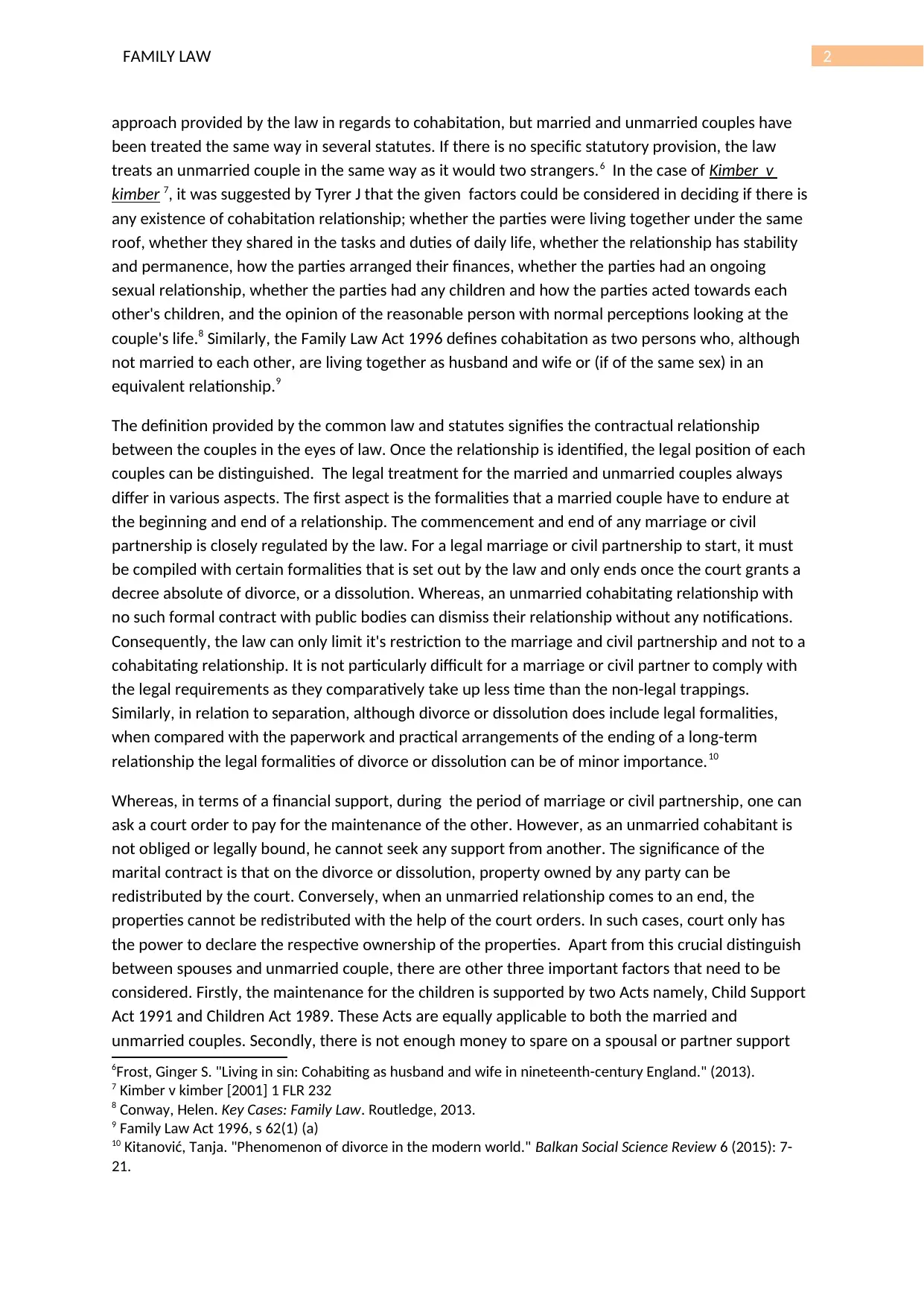
2FAMILY LAW
approach provided by the law in regards to cohabitation, but married and unmarried couples have
been treated the same way in several statutes. If there is no specific statutory provision, the law
treats an unmarried couple in the same way as it would two strangers.6 In the case of Kimber v
kimber 7, it was suggested by Tyrer J that the given factors could be considered in deciding if there is
any existence of cohabitation relationship; whether the parties were living together under the same
roof, whether they shared in the tasks and duties of daily life, whether the relationship has stability
and permanence, how the parties arranged their finances, whether the parties had an ongoing
sexual relationship, whether the parties had any children and how the parties acted towards each
other's children, and the opinion of the reasonable person with normal perceptions looking at the
couple's life.8 Similarly, the Family Law Act 1996 defines cohabitation as two persons who, although
not married to each other, are living together as husband and wife or (if of the same sex) in an
equivalent relationship.9
The definition provided by the common law and statutes signifies the contractual relationship
between the couples in the eyes of law. Once the relationship is identified, the legal position of each
couples can be distinguished. The legal treatment for the married and unmarried couples always
differ in various aspects. The first aspect is the formalities that a married couple have to endure at
the beginning and end of a relationship. The commencement and end of any marriage or civil
partnership is closely regulated by the law. For a legal marriage or civil partnership to start, it must
be compiled with certain formalities that is set out by the law and only ends once the court grants a
decree absolute of divorce, or a dissolution. Whereas, an unmarried cohabitating relationship with
no such formal contract with public bodies can dismiss their relationship without any notifications.
Consequently, the law can only limit it's restriction to the marriage and civil partnership and not to a
cohabitating relationship. It is not particularly difficult for a marriage or civil partner to comply with
the legal requirements as they comparatively take up less time than the non-legal trappings.
Similarly, in relation to separation, although divorce or dissolution does include legal formalities,
when compared with the paperwork and practical arrangements of the ending of a long-term
relationship the legal formalities of divorce or dissolution can be of minor importance.10
Whereas, in terms of a financial support, during the period of marriage or civil partnership, one can
ask a court order to pay for the maintenance of the other. However, as an unmarried cohabitant is
not obliged or legally bound, he cannot seek any support from another. The significance of the
marital contract is that on the divorce or dissolution, property owned by any party can be
redistributed by the court. Conversely, when an unmarried relationship comes to an end, the
properties cannot be redistributed with the help of the court orders. In such cases, court only has
the power to declare the respective ownership of the properties. Apart from this crucial distinguish
between spouses and unmarried couple, there are other three important factors that need to be
considered. Firstly, the maintenance for the children is supported by two Acts namely, Child Support
Act 1991 and Children Act 1989. These Acts are equally applicable to both the married and
unmarried couples. Secondly, there is not enough money to spare on a spousal or partner support
6Frost, Ginger S. "Living in sin: Cohabiting as husband and wife in nineteenth-century England." (2013).
7 Kimber v kimber [2001] 1 FLR 232
8 Conway, Helen. Key Cases: Family Law. Routledge, 2013.
9 Family Law Act 1996, s 62(1) (a)
10 Kitanović, Tanja. "Phenomenon of divorce in the modern world." Balkan Social Science Review 6 (2015): 7-
21.
approach provided by the law in regards to cohabitation, but married and unmarried couples have
been treated the same way in several statutes. If there is no specific statutory provision, the law
treats an unmarried couple in the same way as it would two strangers.6 In the case of Kimber v
kimber 7, it was suggested by Tyrer J that the given factors could be considered in deciding if there is
any existence of cohabitation relationship; whether the parties were living together under the same
roof, whether they shared in the tasks and duties of daily life, whether the relationship has stability
and permanence, how the parties arranged their finances, whether the parties had an ongoing
sexual relationship, whether the parties had any children and how the parties acted towards each
other's children, and the opinion of the reasonable person with normal perceptions looking at the
couple's life.8 Similarly, the Family Law Act 1996 defines cohabitation as two persons who, although
not married to each other, are living together as husband and wife or (if of the same sex) in an
equivalent relationship.9
The definition provided by the common law and statutes signifies the contractual relationship
between the couples in the eyes of law. Once the relationship is identified, the legal position of each
couples can be distinguished. The legal treatment for the married and unmarried couples always
differ in various aspects. The first aspect is the formalities that a married couple have to endure at
the beginning and end of a relationship. The commencement and end of any marriage or civil
partnership is closely regulated by the law. For a legal marriage or civil partnership to start, it must
be compiled with certain formalities that is set out by the law and only ends once the court grants a
decree absolute of divorce, or a dissolution. Whereas, an unmarried cohabitating relationship with
no such formal contract with public bodies can dismiss their relationship without any notifications.
Consequently, the law can only limit it's restriction to the marriage and civil partnership and not to a
cohabitating relationship. It is not particularly difficult for a marriage or civil partner to comply with
the legal requirements as they comparatively take up less time than the non-legal trappings.
Similarly, in relation to separation, although divorce or dissolution does include legal formalities,
when compared with the paperwork and practical arrangements of the ending of a long-term
relationship the legal formalities of divorce or dissolution can be of minor importance.10
Whereas, in terms of a financial support, during the period of marriage or civil partnership, one can
ask a court order to pay for the maintenance of the other. However, as an unmarried cohabitant is
not obliged or legally bound, he cannot seek any support from another. The significance of the
marital contract is that on the divorce or dissolution, property owned by any party can be
redistributed by the court. Conversely, when an unmarried relationship comes to an end, the
properties cannot be redistributed with the help of the court orders. In such cases, court only has
the power to declare the respective ownership of the properties. Apart from this crucial distinguish
between spouses and unmarried couple, there are other three important factors that need to be
considered. Firstly, the maintenance for the children is supported by two Acts namely, Child Support
Act 1991 and Children Act 1989. These Acts are equally applicable to both the married and
unmarried couples. Secondly, there is not enough money to spare on a spousal or partner support
6Frost, Ginger S. "Living in sin: Cohabiting as husband and wife in nineteenth-century England." (2013).
7 Kimber v kimber [2001] 1 FLR 232
8 Conway, Helen. Key Cases: Family Law. Routledge, 2013.
9 Family Law Act 1996, s 62(1) (a)
10 Kitanović, Tanja. "Phenomenon of divorce in the modern world." Balkan Social Science Review 6 (2015): 7-
21.
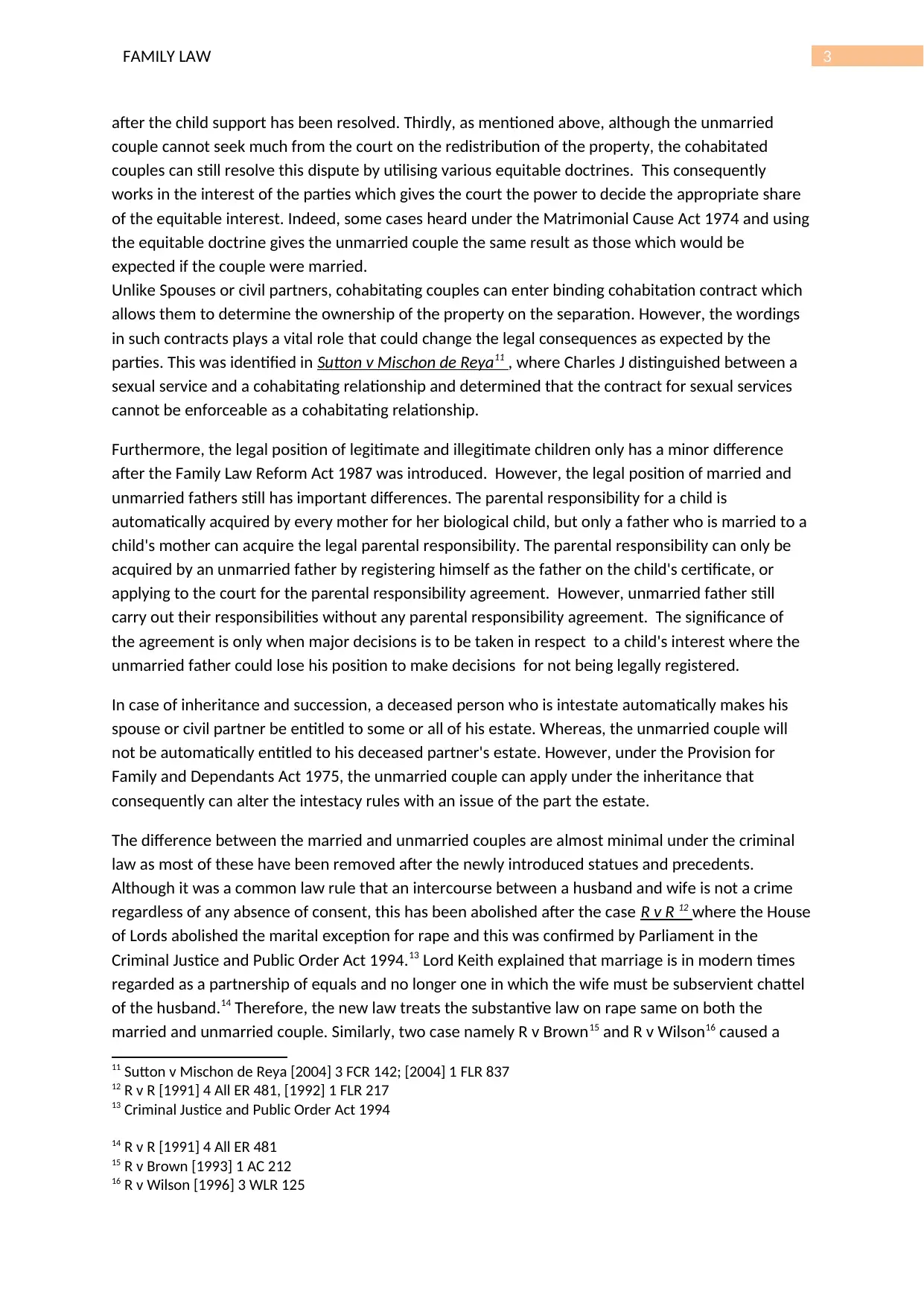
3FAMILY LAW
after the child support has been resolved. Thirdly, as mentioned above, although the unmarried
couple cannot seek much from the court on the redistribution of the property, the cohabitated
couples can still resolve this dispute by utilising various equitable doctrines. This consequently
works in the interest of the parties which gives the court the power to decide the appropriate share
of the equitable interest. Indeed, some cases heard under the Matrimonial Cause Act 1974 and using
the equitable doctrine gives the unmarried couple the same result as those which would be
expected if the couple were married.
Unlike Spouses or civil partners, cohabitating couples can enter binding cohabitation contract which
allows them to determine the ownership of the property on the separation. However, the wordings
in such contracts plays a vital role that could change the legal consequences as expected by the
parties. This was identified in Sutton v Mischon de Reya11 , where Charles J distinguished between a
sexual service and a cohabitating relationship and determined that the contract for sexual services
cannot be enforceable as a cohabitating relationship.
Furthermore, the legal position of legitimate and illegitimate children only has a minor difference
after the Family Law Reform Act 1987 was introduced. However, the legal position of married and
unmarried fathers still has important differences. The parental responsibility for a child is
automatically acquired by every mother for her biological child, but only a father who is married to a
child's mother can acquire the legal parental responsibility. The parental responsibility can only be
acquired by an unmarried father by registering himself as the father on the child's certificate, or
applying to the court for the parental responsibility agreement. However, unmarried father still
carry out their responsibilities without any parental responsibility agreement. The significance of
the agreement is only when major decisions is to be taken in respect to a child's interest where the
unmarried father could lose his position to make decisions for not being legally registered.
In case of inheritance and succession, a deceased person who is intestate automatically makes his
spouse or civil partner be entitled to some or all of his estate. Whereas, the unmarried couple will
not be automatically entitled to his deceased partner's estate. However, under the Provision for
Family and Dependants Act 1975, the unmarried couple can apply under the inheritance that
consequently can alter the intestacy rules with an issue of the part the estate.
The difference between the married and unmarried couples are almost minimal under the criminal
law as most of these have been removed after the newly introduced statues and precedents.
Although it was a common law rule that an intercourse between a husband and wife is not a crime
regardless of any absence of consent, this has been abolished after the case R v R 12 where the House
of Lords abolished the marital exception for rape and this was confirmed by Parliament in the
Criminal Justice and Public Order Act 1994.13 Lord Keith explained that marriage is in modern times
regarded as a partnership of equals and no longer one in which the wife must be subservient chattel
of the husband.14 Therefore, the new law treats the substantive law on rape same on both the
married and unmarried couple. Similarly, two case namely R v Brown15 and R v Wilson16 caused a
11 Sutton v Mischon de Reya [2004] 3 FCR 142; [2004] 1 FLR 837
12 R v R [1991] 4 All ER 481, [1992] 1 FLR 217
13 Criminal Justice and Public Order Act 1994
14 R v R [1991] 4 All ER 481
15 R v Brown [1993] 1 AC 212
16 R v Wilson [1996] 3 WLR 125
after the child support has been resolved. Thirdly, as mentioned above, although the unmarried
couple cannot seek much from the court on the redistribution of the property, the cohabitated
couples can still resolve this dispute by utilising various equitable doctrines. This consequently
works in the interest of the parties which gives the court the power to decide the appropriate share
of the equitable interest. Indeed, some cases heard under the Matrimonial Cause Act 1974 and using
the equitable doctrine gives the unmarried couple the same result as those which would be
expected if the couple were married.
Unlike Spouses or civil partners, cohabitating couples can enter binding cohabitation contract which
allows them to determine the ownership of the property on the separation. However, the wordings
in such contracts plays a vital role that could change the legal consequences as expected by the
parties. This was identified in Sutton v Mischon de Reya11 , where Charles J distinguished between a
sexual service and a cohabitating relationship and determined that the contract for sexual services
cannot be enforceable as a cohabitating relationship.
Furthermore, the legal position of legitimate and illegitimate children only has a minor difference
after the Family Law Reform Act 1987 was introduced. However, the legal position of married and
unmarried fathers still has important differences. The parental responsibility for a child is
automatically acquired by every mother for her biological child, but only a father who is married to a
child's mother can acquire the legal parental responsibility. The parental responsibility can only be
acquired by an unmarried father by registering himself as the father on the child's certificate, or
applying to the court for the parental responsibility agreement. However, unmarried father still
carry out their responsibilities without any parental responsibility agreement. The significance of
the agreement is only when major decisions is to be taken in respect to a child's interest where the
unmarried father could lose his position to make decisions for not being legally registered.
In case of inheritance and succession, a deceased person who is intestate automatically makes his
spouse or civil partner be entitled to some or all of his estate. Whereas, the unmarried couple will
not be automatically entitled to his deceased partner's estate. However, under the Provision for
Family and Dependants Act 1975, the unmarried couple can apply under the inheritance that
consequently can alter the intestacy rules with an issue of the part the estate.
The difference between the married and unmarried couples are almost minimal under the criminal
law as most of these have been removed after the newly introduced statues and precedents.
Although it was a common law rule that an intercourse between a husband and wife is not a crime
regardless of any absence of consent, this has been abolished after the case R v R 12 where the House
of Lords abolished the marital exception for rape and this was confirmed by Parliament in the
Criminal Justice and Public Order Act 1994.13 Lord Keith explained that marriage is in modern times
regarded as a partnership of equals and no longer one in which the wife must be subservient chattel
of the husband.14 Therefore, the new law treats the substantive law on rape same on both the
married and unmarried couple. Similarly, two case namely R v Brown15 and R v Wilson16 caused a
11 Sutton v Mischon de Reya [2004] 3 FCR 142; [2004] 1 FLR 837
12 R v R [1991] 4 All ER 481, [1992] 1 FLR 217
13 Criminal Justice and Public Order Act 1994
14 R v R [1991] 4 All ER 481
15 R v Brown [1993] 1 AC 212
16 R v Wilson [1996] 3 WLR 125
Secure Best Marks with AI Grader
Need help grading? Try our AI Grader for instant feedback on your assignments.
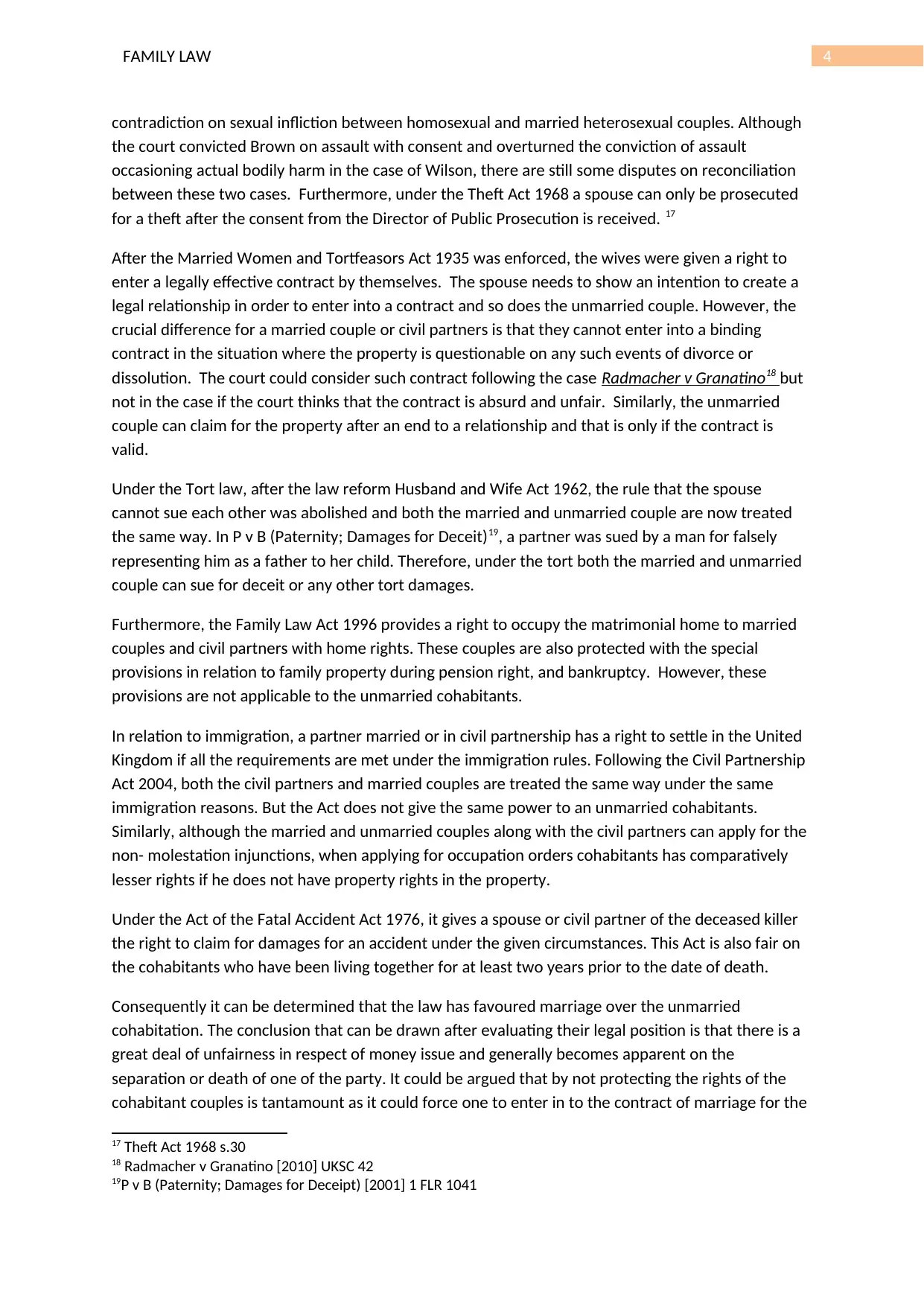
4FAMILY LAW
contradiction on sexual infliction between homosexual and married heterosexual couples. Although
the court convicted Brown on assault with consent and overturned the conviction of assault
occasioning actual bodily harm in the case of Wilson, there are still some disputes on reconciliation
between these two cases. Furthermore, under the Theft Act 1968 a spouse can only be prosecuted
for a theft after the consent from the Director of Public Prosecution is received. 17
After the Married Women and Tortfeasors Act 1935 was enforced, the wives were given a right to
enter a legally effective contract by themselves. The spouse needs to show an intention to create a
legal relationship in order to enter into a contract and so does the unmarried couple. However, the
crucial difference for a married couple or civil partners is that they cannot enter into a binding
contract in the situation where the property is questionable on any such events of divorce or
dissolution. The court could consider such contract following the case Radmacher v Granatino18 but
not in the case if the court thinks that the contract is absurd and unfair. Similarly, the unmarried
couple can claim for the property after an end to a relationship and that is only if the contract is
valid.
Under the Tort law, after the law reform Husband and Wife Act 1962, the rule that the spouse
cannot sue each other was abolished and both the married and unmarried couple are now treated
the same way. In P v B (Paternity; Damages for Deceit)19, a partner was sued by a man for falsely
representing him as a father to her child. Therefore, under the tort both the married and unmarried
couple can sue for deceit or any other tort damages.
Furthermore, the Family Law Act 1996 provides a right to occupy the matrimonial home to married
couples and civil partners with home rights. These couples are also protected with the special
provisions in relation to family property during pension right, and bankruptcy. However, these
provisions are not applicable to the unmarried cohabitants.
In relation to immigration, a partner married or in civil partnership has a right to settle in the United
Kingdom if all the requirements are met under the immigration rules. Following the Civil Partnership
Act 2004, both the civil partners and married couples are treated the same way under the same
immigration reasons. But the Act does not give the same power to an unmarried cohabitants.
Similarly, although the married and unmarried couples along with the civil partners can apply for the
non- molestation injunctions, when applying for occupation orders cohabitants has comparatively
lesser rights if he does not have property rights in the property.
Under the Act of the Fatal Accident Act 1976, it gives a spouse or civil partner of the deceased killer
the right to claim for damages for an accident under the given circumstances. This Act is also fair on
the cohabitants who have been living together for at least two years prior to the date of death.
Consequently it can be determined that the law has favoured marriage over the unmarried
cohabitation. The conclusion that can be drawn after evaluating their legal position is that there is a
great deal of unfairness in respect of money issue and generally becomes apparent on the
separation or death of one of the party. It could be argued that by not protecting the rights of the
cohabitant couples is tantamount as it could force one to enter in to the contract of marriage for the
17 Theft Act 1968 s.30
18 Radmacher v Granatino [2010] UKSC 42
19P v B (Paternity; Damages for Deceipt) [2001] 1 FLR 1041
contradiction on sexual infliction between homosexual and married heterosexual couples. Although
the court convicted Brown on assault with consent and overturned the conviction of assault
occasioning actual bodily harm in the case of Wilson, there are still some disputes on reconciliation
between these two cases. Furthermore, under the Theft Act 1968 a spouse can only be prosecuted
for a theft after the consent from the Director of Public Prosecution is received. 17
After the Married Women and Tortfeasors Act 1935 was enforced, the wives were given a right to
enter a legally effective contract by themselves. The spouse needs to show an intention to create a
legal relationship in order to enter into a contract and so does the unmarried couple. However, the
crucial difference for a married couple or civil partners is that they cannot enter into a binding
contract in the situation where the property is questionable on any such events of divorce or
dissolution. The court could consider such contract following the case Radmacher v Granatino18 but
not in the case if the court thinks that the contract is absurd and unfair. Similarly, the unmarried
couple can claim for the property after an end to a relationship and that is only if the contract is
valid.
Under the Tort law, after the law reform Husband and Wife Act 1962, the rule that the spouse
cannot sue each other was abolished and both the married and unmarried couple are now treated
the same way. In P v B (Paternity; Damages for Deceit)19, a partner was sued by a man for falsely
representing him as a father to her child. Therefore, under the tort both the married and unmarried
couple can sue for deceit or any other tort damages.
Furthermore, the Family Law Act 1996 provides a right to occupy the matrimonial home to married
couples and civil partners with home rights. These couples are also protected with the special
provisions in relation to family property during pension right, and bankruptcy. However, these
provisions are not applicable to the unmarried cohabitants.
In relation to immigration, a partner married or in civil partnership has a right to settle in the United
Kingdom if all the requirements are met under the immigration rules. Following the Civil Partnership
Act 2004, both the civil partners and married couples are treated the same way under the same
immigration reasons. But the Act does not give the same power to an unmarried cohabitants.
Similarly, although the married and unmarried couples along with the civil partners can apply for the
non- molestation injunctions, when applying for occupation orders cohabitants has comparatively
lesser rights if he does not have property rights in the property.
Under the Act of the Fatal Accident Act 1976, it gives a spouse or civil partner of the deceased killer
the right to claim for damages for an accident under the given circumstances. This Act is also fair on
the cohabitants who have been living together for at least two years prior to the date of death.
Consequently it can be determined that the law has favoured marriage over the unmarried
cohabitation. The conclusion that can be drawn after evaluating their legal position is that there is a
great deal of unfairness in respect of money issue and generally becomes apparent on the
separation or death of one of the party. It could be argued that by not protecting the rights of the
cohabitant couples is tantamount as it could force one to enter in to the contract of marriage for the
17 Theft Act 1968 s.30
18 Radmacher v Granatino [2010] UKSC 42
19P v B (Paternity; Damages for Deceipt) [2001] 1 FLR 1041

5FAMILY LAW
sake of the benefits attached to married couples. However, it can be counter argued that the
marriage is only the legal formality and if the couples wants to live together regardless then it should
not matter if they want to undergo a formal marriage ceremony.
Although the married spouse and civil partners are protected by various legislation, couples who
choose to cohabitate without marriage can end their relationship without any legal hurdles and
costs. Since both the civil partners under the Civil Partnership Act 2004 and married couples has to
go through the formalities of divorce to end their relationship, it can be extremely expensive and
stressful at times. Due to this reason cohabitant couples would opt for cohabitation as opposed to
marriage as it could less for the formalities on both starting or ending a relationship.
sake of the benefits attached to married couples. However, it can be counter argued that the
marriage is only the legal formality and if the couples wants to live together regardless then it should
not matter if they want to undergo a formal marriage ceremony.
Although the married spouse and civil partners are protected by various legislation, couples who
choose to cohabitate without marriage can end their relationship without any legal hurdles and
costs. Since both the civil partners under the Civil Partnership Act 2004 and married couples has to
go through the formalities of divorce to end their relationship, it can be extremely expensive and
stressful at times. Due to this reason cohabitant couples would opt for cohabitation as opposed to
marriage as it could less for the formalities on both starting or ending a relationship.
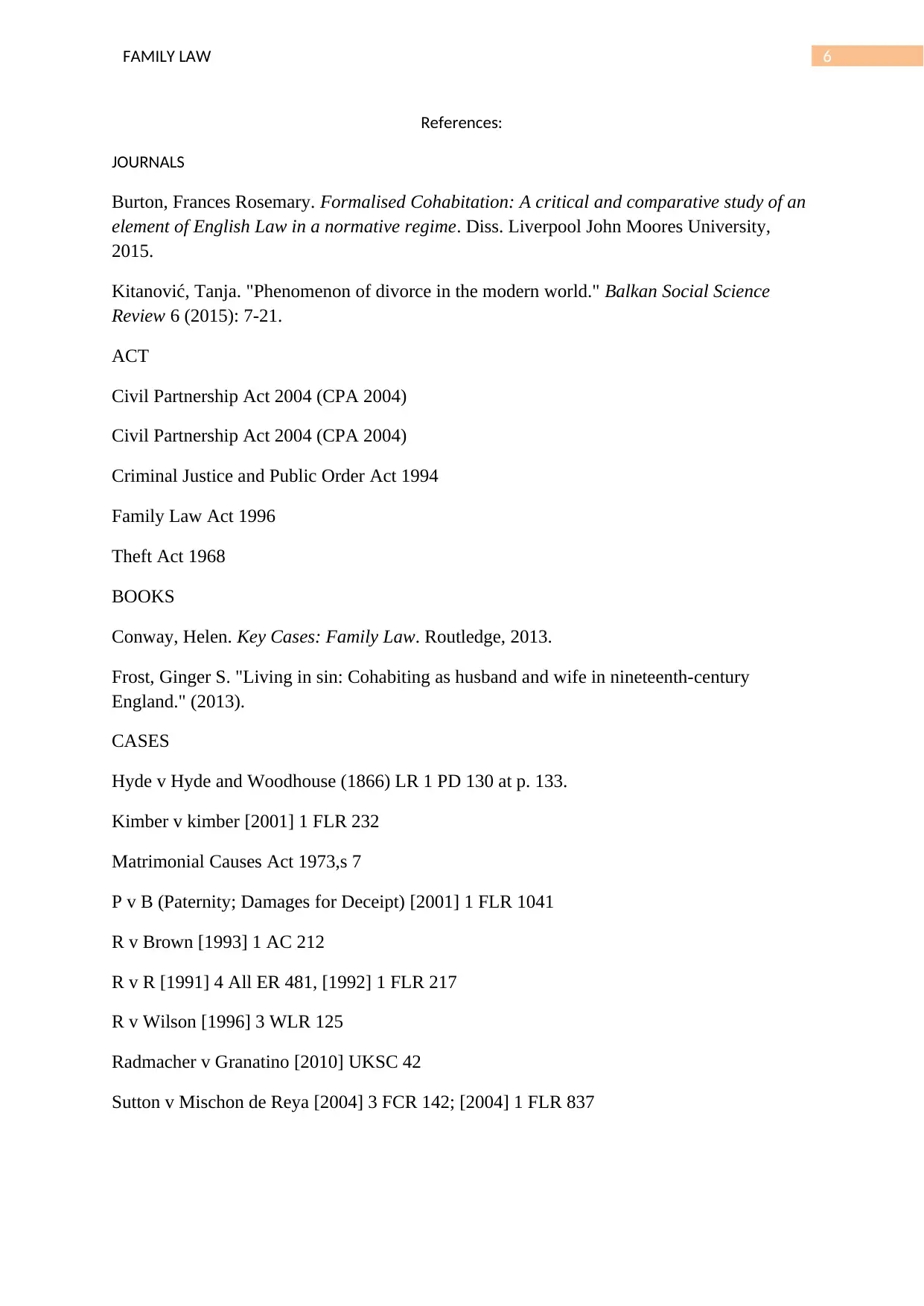
6FAMILY LAW
References:
JOURNALS
Burton, Frances Rosemary. Formalised Cohabitation: A critical and comparative study of an
element of English Law in a normative regime. Diss. Liverpool John Moores University,
2015.
Kitanović, Tanja. "Phenomenon of divorce in the modern world." Balkan Social Science
Review 6 (2015): 7-21.
ACT
Civil Partnership Act 2004 (CPA 2004)
Civil Partnership Act 2004 (CPA 2004)
Criminal Justice and Public Order Act 1994
Family Law Act 1996
Theft Act 1968
BOOKS
Conway, Helen. Key Cases: Family Law. Routledge, 2013.
Frost, Ginger S. "Living in sin: Cohabiting as husband and wife in nineteenth-century
England." (2013).
CASES
Hyde v Hyde and Woodhouse (1866) LR 1 PD 130 at p. 133.
Kimber v kimber [2001] 1 FLR 232
Matrimonial Causes Act 1973,s 7
P v B (Paternity; Damages for Deceipt) [2001] 1 FLR 1041
R v Brown [1993] 1 AC 212
R v R [1991] 4 All ER 481, [1992] 1 FLR 217
R v Wilson [1996] 3 WLR 125
Radmacher v Granatino [2010] UKSC 42
Sutton v Mischon de Reya [2004] 3 FCR 142; [2004] 1 FLR 837
References:
JOURNALS
Burton, Frances Rosemary. Formalised Cohabitation: A critical and comparative study of an
element of English Law in a normative regime. Diss. Liverpool John Moores University,
2015.
Kitanović, Tanja. "Phenomenon of divorce in the modern world." Balkan Social Science
Review 6 (2015): 7-21.
ACT
Civil Partnership Act 2004 (CPA 2004)
Civil Partnership Act 2004 (CPA 2004)
Criminal Justice and Public Order Act 1994
Family Law Act 1996
Theft Act 1968
BOOKS
Conway, Helen. Key Cases: Family Law. Routledge, 2013.
Frost, Ginger S. "Living in sin: Cohabiting as husband and wife in nineteenth-century
England." (2013).
CASES
Hyde v Hyde and Woodhouse (1866) LR 1 PD 130 at p. 133.
Kimber v kimber [2001] 1 FLR 232
Matrimonial Causes Act 1973,s 7
P v B (Paternity; Damages for Deceipt) [2001] 1 FLR 1041
R v Brown [1993] 1 AC 212
R v R [1991] 4 All ER 481, [1992] 1 FLR 217
R v Wilson [1996] 3 WLR 125
Radmacher v Granatino [2010] UKSC 42
Sutton v Mischon de Reya [2004] 3 FCR 142; [2004] 1 FLR 837
1 out of 7
Related Documents
Your All-in-One AI-Powered Toolkit for Academic Success.
+13062052269
info@desklib.com
Available 24*7 on WhatsApp / Email
![[object Object]](/_next/static/media/star-bottom.7253800d.svg)
Unlock your academic potential
© 2024 | Zucol Services PVT LTD | All rights reserved.



